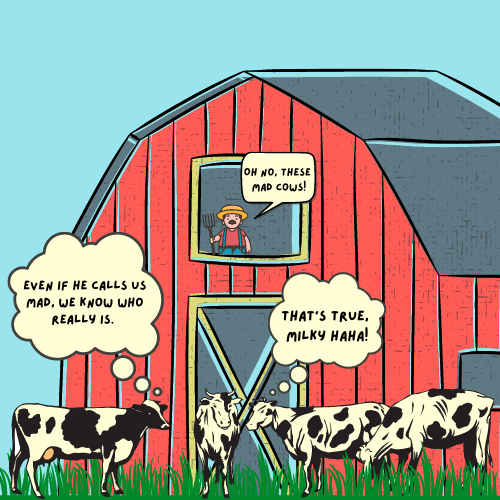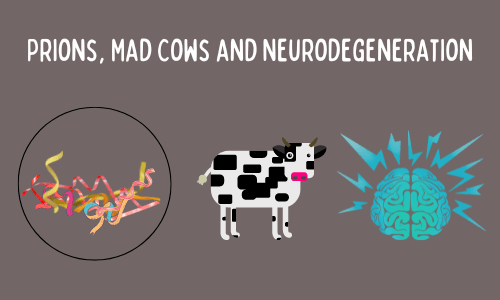A neurodegenerative disease that spreads? That too with the help of prions? Bovine Spongiform Encephalopathy (BSE) is a disease that primarily affects cattle but it affects humans as well. The study of Bovine Spongiform Encephalopathy or its human counterpart Creutzfeldt Jakob disease (CJD) is important because of its very unusual causative agent; prion. Bovine Spongiform Encephalopathy is also known as Mad Cow disease, which is a much more familiar name. In the critically acclaimed novel, ‘The Discomfort of Evening’, Marieke Lucas Rijneveld has wonderfully written the turmoil of a ten-year-old girl, whose parents run a cattle farm, where the cattle have been slowly succumbing to Mad Cow disease.
Let’s get a few facts straight, what exactly are prions and neurodegenerative diseases? How do these prions cause infectious disease, that too a neurodegenerative disease that can also affect humans by diseased meat? How curable is this disease? How does the disease progress? These are some of the questions that I hope to cover through the entirety of the article and some of the initial thoughts I had when I first came across the disease pathology of this very rare disease.
But first, prions. We know of normal proteins, that have their primary, secondary, and tertiary structures, fold perfectly and participate in metabolic activities, and are present in the cell membranes as integral and peripheral proteins. Prions however are not folded perfectly, that is, they are misfolded and harness the ability to spread this imperfection to their normal counterparts. These so-called misfolded proteins are what cause various forms of neurodegenerative diseases in animals by binding to their normal equivalents and stimulating changes in shapes.

Prions are peculiar and a challenging biological puzzle for the simple reason that they are proteins that cause the infection rather than a bacterium, fungi, or a virus. But how do biologists understand that a prion is a protein rather than a virus or a bacteria? It was by the degradation that the prion underwent after its treatment with chemicals that degrade proteins but not chemicals that degrade nucleic acids. The prion, that translates to infectious protein has two forms — a normal secure form (pN) and a misfolded form — and this misfolded form (pD) can cause other proteins to be misfolded as mentioned above.
The changes in the conformation of the protein are highly contagious that cause extensive damage to neuronal proteins leading to neurodegeneration, which is in short causing damage to the brain and is manifested by other conditions such as dementia and frequent muscle jerks. There is also evidence for the appearance of amyloid plaques in Creutzfeldt Jakob disease. Amyloid plaques are a result of the buildup of such misfolded proteins and these proteins aggregate themselves amongst the neurons. Such plaques are also seen in diseases such as Alzheimer’s and have enthralled scientists because of similar disease pathology of most neurodegenerative diseases caused by prions.
Patients infected with Creutzfeldt disease have a life expectancy of less than a year after the onset of symptoms because of its dangerous and infectious progression. Humans can contract the disease by infected bovine meat, thus emphasizing the role of appropriate food safety regulations for the safe consumption of meat. It was also observed that cerebral atrophy occurred in patients; it is a loss of established neuronal connections that is important for learning and other daily activities. This is a result of the damage caused as a result of the misfolded protein that now does not function or has a deleterious effect on various activities of the brain such as mental processing, which brings about conditions such as dementia as previously described.
It is also interesting to explore the epidemiology of the disease with respect to various mutations at the genetic level or with different strains or multitudes of prions. A gene called PRNP gene which encodes for the prion protein whose variant called PrPSc is a genetic cause that is responsible for the manifestation of various neurodegenerative diseases such as ovine scrapie, Bovine spongiform encephalopathy, Creutzfeldt Jakob disease (CJD), exotic ungulate encephalopathy and so on. There has been evidence of familial Creutzfeldt Jakob diseases being transmitted across generations because of mutations in this PRNP gene.
Because of its very unusual method of transmission, prion diseases are very hard to diagnose which subsequently makes the treatment of prion diseases difficult. A definite diagnosis of prion diseases can only be done after death, through post-mortem analysis that shows the amyloid plaques through which the disease progressed initially. There are techniques that however have been developed recently that make use of antibodies that detect the protease resistant prion protein PrPSc, spectroscopic techniques, and so on. These techniques have the advantage of being rapid and simple and are not invasive and there are fewer chances of false-negative results. Other techniques depending on the stage of the disease progression include brain magnetic resonance imaging and a very specific test for the detection of prion diseases called RT-QuIC or Real-Time Quaking Induced Conversion on the cerebrospinal fluid of the patient under treatment.

Future efforts could be directed towards understanding the exact mechanism of folding so that there can be clinical interventions to slow down or mitigate the progression of misfolding through the infectious protein particle. The resistance of various prions towards different types of drugs have also been a challenge towards combating prion diseases. There are also various efforts to include innovative drug candidates such as engineered biomolecules or polymers to combat the disease. Thus such a collective, multidisciplinary approach to treating such dangerous conditions and correctly diagnosing them would help us in the fight against these fatal neurodegenerative, rare and infectious brain diseases.
References:
. . .
Writer
Thara Bastian Antony
Illustrator
Urja Kuber
Editor
Eesha Gupte

